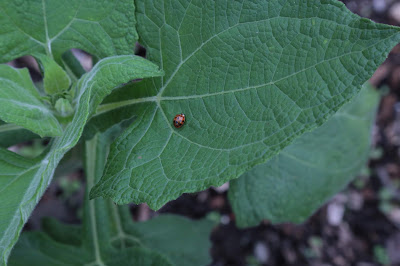IPM: What you Need to Know!
IPM a.k.a. Integrated Pest Management groups together Best Management Practices that can help prevent, treat, and eradicate pests causing problems for your plants. The most important step when it comes to pests is prevention, once the pest is already an infestation it is not always easy to get rid of.
Biological: releasing and/or maintaining natural enemies and biological organisms. One example is this beautiful lady bug relaxing on our Smallanthus sonchifolius. Lady bugs eat many common pests like aphids, white fly and mites. Many commercial greenhouses will release lady bugs bought in bulk.
Chemical: when chemicals are necessary to use; be sure to read labels and use safely.
Cultural: maintaining the proper environment for your plant based on its needs. This includes but is not limited to mowing, pruning, irrigation, and mulching.
When you are planning a garden make sure to take these measures into account and always remember to plan ahead! Crops all have different types of pests and different ways to deal with them. A variety of oils and soaps can be used to control some insect pests and mites.
Sources: http://livinggreen.ifas.ufl.edu/landscaping/ipm.html#cultural
http://sfyl.ifas.ufl.edu/agriculture/proper-herbicide-application/
http://gardeningsolutions.ifas.ufl.edu/care/planting/mulch.html
Below are 3 different types of IPM:
Biological: releasing and/or maintaining natural enemies and biological organisms. One example is this beautiful lady bug relaxing on our Smallanthus sonchifolius. Lady bugs eat many common pests like aphids, white fly and mites. Many commercial greenhouses will release lady bugs bought in bulk.
Chemical: when chemicals are necessary to use; be sure to read labels and use safely.
Cultural: maintaining the proper environment for your plant based on its needs. This includes but is not limited to mowing, pruning, irrigation, and mulching.
When you are planning a garden make sure to take these measures into account and always remember to plan ahead! Crops all have different types of pests and different ways to deal with them. A variety of oils and soaps can be used to control some insect pests and mites.
Sources: http://livinggreen.ifas.ufl.edu/landscaping/ipm.html#cultural
http://sfyl.ifas.ufl.edu/agriculture/proper-herbicide-application/
http://gardeningsolutions.ifas.ufl.edu/care/planting/mulch.html





Comments
Post a Comment